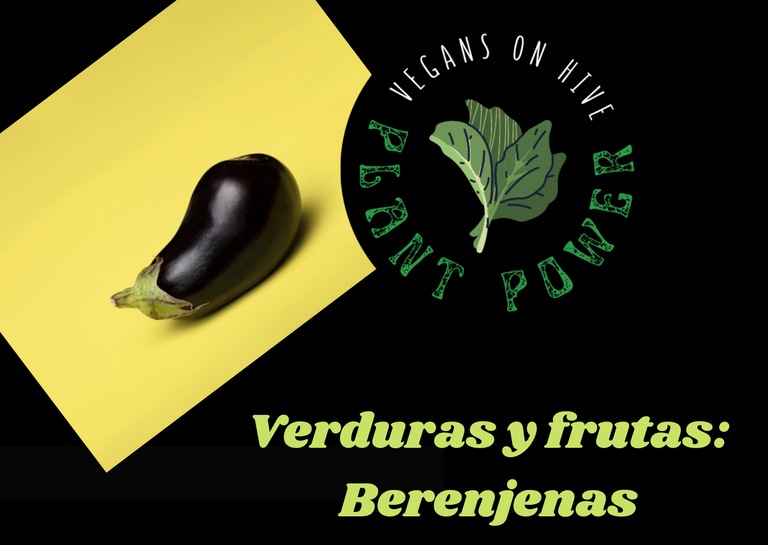
ENGLISH
Hello plant-based foodies, wherever you are in the world and/or galaxy!
Here @sirenahippie

This fruit grows on a small bush and can be harvested once or twice a year. Its shelf life is short, so it should be refrigerated in a dry container, or better yet, wrapped in absorbent paper. However, the longest it will be good is 10 to 15 days. It is a fruit with few vitamins and minerals, primarily potassium, although it also contains phosphorus, calcium, magnesium, and iron, as well as small amounts of B vitamins. This fruit is composed primarily of water, making it low in calories. It also has a certain amount of fiber, which is distributed in the peel and seeds.

Eggplants, like any other fruit or vegetable, can be eaten with their skin AS LONG AS THEY ARE ORGANIC. They generally have a bitter taste, which can be removed by soaking them in salt water. They are generally used for savory recipes, and not all cooking techniques are suitable for their processing. Below are some ways to cook them.

WAYS TO COOK AUBERGINE (EGGPLANT)
- Roasted: They can be placed still in their skins, directly on the coals or in the fire, turning them over as they roast; this will give them a delicious smoky flavor. They can also be wrapped in aluminum foil and placed on the fire or embers. Afterward, they can be pureed and tossed with salt, spices, oil, and tahini, creating a delicious creamy consistency.
- Fried: To do this, you need to slice them, peel included, and soak them for a day in salt water. This eliminates the bitter taste, and they won't absorb oil when cooked. Otherwise, they'll absorb too much oil.
- Stewed: Chopped and accompanied with other vegetables, spices and a small amount of oil.
- Baked: They can be baked whole or with the skin on. It's recommended to wrap them in aluminum foil. Add oil, spices, and salt to give them extra flavor. They can also be sliced and made into pies alternating layers of eggplant with other vegetable stew.
- Stuffed: They can be filled with rice, textured soy, and various vegetables.
- Pickled: With vinegar, salt, oil, garlic, spices, processed properly and hygienically, they can last a year.

As you can see, eggplant is a versatile and delicious fruit, with which you can enrich your vegan recipes, so we invite you to experiment with new recipes with it


ESPAÑOL

¡Hola amantes de los alimentos basados en plantas, donde quiera que estén en el mundo y/o la galaxia!
Aquí @sirenahippie

Esta fruta crece de un pequeño arbusto, pudiendo cosecharse una o dos veces al año. Su conservación es breve, para lo cual se debe refrigerar, en un recipiente seco, o mejor aún, envueltas en papel absorbo; no obstante la máximo que estará en buen estado será por 10 a 15 días. Es una fruta con poca cantidad de vitaminas y minerales, fundamentalmente potasio, aunque también tiene fósforo, calcio, magnesio y hierro, así como pocas cantidades de vitaminas del complejo B. Esta fruta está compuesta fundamentalmente por agua, por lo que es hipocalórica. Tiene cierta cantidad de fibra, que se distribuye en la cáscara y semillas.

Las berenjenas, al igual que cualquier otra fruta o vegetal, pueden consumirse con cáscara SIEMPRE Y CUANDO SEAN ORGÁNICAS. Por lo general tiene un gusto amargo, que puede eliminarse remojándola en agua salada. Generalmente se utiliza para recetas saladas, y no todas las técnicas culinarias son adecuadas para su procesamiento. A continuación señalamos algunas formas de cocinarlas.

FORMAS DE COCINAR LAS BERENJENAS
- Asadas: Pueden colocarse aún con la cáscara, directamente sobre las brasas o en el fuego, dándoles vueltas mientras se van asando, esto les aportará un toque ahumado delicioso. También pueden envolverse en papel aluminio y colocarlas al fuego o brasas. Luego de esto, pueden hacerse puré y añadirles sal, especias, aceite y tahini, obteniéndose una crema deliciosa.
- Fritas: Para ello se requiere rebanarlas con la cáscara incluida, y remojarlas por un día en agua salada. De este modo, se elimina el sabor amargo, y al cocinarlas no absorberán aceite. Caso contrario, absorberán mucho aceite.
- Guisadas: Trocedadas y acompañadas con otros vegetales, especias y una poca cantidad de aceite.
- Horneada: Pueden hornearse enteras y con piel. Es recomendable envolverlas en papel de alumnio. Se les añade aceite, especias y sal para darles más sabor. También pueden cortarse en láminas, y hacer pasteles alternando capas de berenjena con guiso de otros vegetales.
- Rellenas: Se pueden rellenar con arroz, soya texturizada y diversos vegetales.
- En conservas: Con vinagre, aceite, ajos, especias, procesándolas adecuadamente y con higiene, pueden durar un año.

Como pueden ver, la berenjena es un fruto versátil y delicioso, con el cual pueden enriquecer sus recetarios veganos, así que les invitamos a experimentar nuevas recetas con ella

BIBLIOGRAPHY / BIBLIOGRAFÍA

RELATED POSTS / POSTS RELACIONADOS
Vegetables and fruits: Pumpkin / Verduras y frutas: Calabaza (ENG / SPN)
Ideas for starting a vegan diet / Ideas para iniciar una alimentación vegana (ENG / SPN)
Vegan substitutes / Sustitutos veganos (ENG / SPN)
Vegetarian eating styles / Estilos de alimentación vegetariana (ENG / SPN)


Delegations welcome!